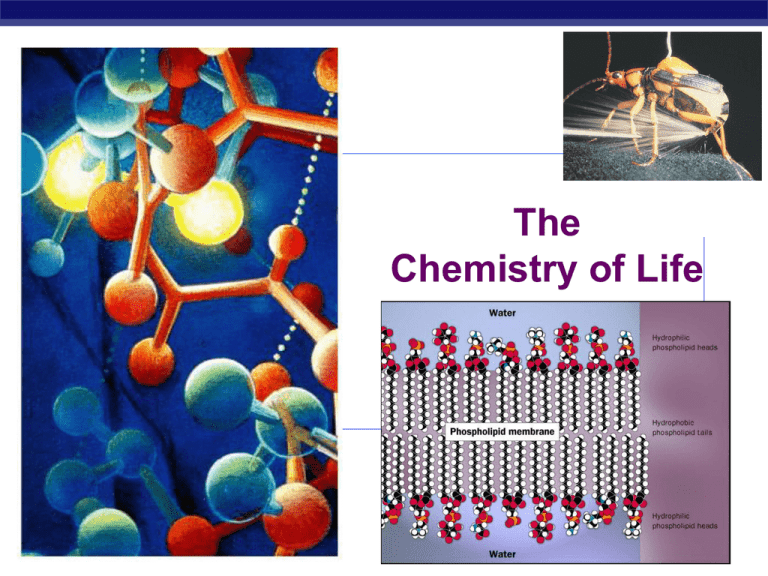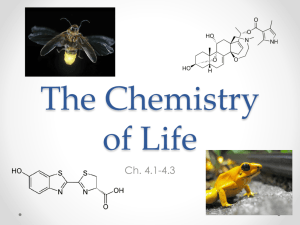Properties of Water
advertisement

The Chemistry of Life AP Biology 2007-2008 Why are we studying chemistry? Chemistry is the foundation of Biology AP Biology Everything is made of matter Matter is made of atoms Hydrogen 1 proton 1 electron Oxygen 8 protons 8 neutrons 8 electrons AP Biology Proton + Neutron 0 Electron – The World of Elements H C N O Na Mg P S K Ca Different kinds of atoms = elements AP Biology Life requires ~25 chemical elements About 25 elements are essential for life AP Biology Four elements make up 96% of living matter: • carbon (C) • hydrogen (H) • oxygen (O) • nitrogen (N) Four elements make up most of remaining 4%: • phosphorus (P) • calcium (Ca) • sulfur (S) • potassium (K) Bonding properties Effect of electrons electrons determine chemical behavior of atom depends on number of electrons in atom’s outermost shell valence shell How does this atom behave? AP Biology Bonding properties What’s the magic number? Effect of electrons How AP Biology chemical behavior of an atom depends on number of electrons in its valence shell does this atom behave? How does this atom behave? Elements & their valence shells Elements in the same row have the same number of shells Moving from left to right, each element has a AP Biology sequential addition of electrons (& protons) Elements & their valence shells Elements in the same column have the same valence & similar chemical properties Remember some food chains are built on reducing O to H2O & some on reducing S to H2S AP Biology Chemical reactivity Atoms tend to complete a partially filled valence shell or empty a partially filled valence shell This tendency drives chemical reactions… and creates bonds – – – AP Biology Hydrogen bond Bonds in Biology Weak bonds H2O hydrogen bonds attraction between + and – H2O hydrophobic & hydrophilic interactions Covalent bond interaction with H2O van derWaals forces – (ionic) Strong bonds AP Biology – covalent bonds H2 (hydrogen gas) Covalent bonds Why are covalent bonds strong bonds? two atoms share a pair of electrons both atoms holding onto the electrons very stable Forms molecules H – H H—H O Oxygen H – H AP Biology H2 (hydrogen gas) H2O (water) Multiple covalent bonds 2 atoms can share >1 pair of electrons double bonds 2 pairs of electrons triple bonds 3 pairs of electrons Very strong bonds H – More is better! – H–C–H AP Biology H Nonpolar covalent bond Pair of electrons shared equally by 2 atoms example: hydrocarbons = CxHx methane (CH4 ) QuickTime™ and a TIFF (Uncompressed) decompressor are needed to see this picture. QuickTime™ and a TIFF (Uncompressed) decompressor are needed to see this picture. AP Biology balanced, stable, good building block Polar covalent bonds Pair of electrons shared unequally by 2 atoms example: water = H2O oxygen has stronger + “attraction” for the electrons than hydrogen oxygen has higher electronegativity water is a polar molecule + vs – poles leads to many interesting + – H Oxygen H properties of water… AP Biology – – – Hydrogen bonding Polar water creates molecular attractions attraction between positive H in one H2O molecule to negative O in another H2O also can occur wherever H H an -OH exists in a larger O molecule Weak bond Let’s go to the videotape! AP Biology Chemistry of Life Properties of Water AP Biology 2007-2008 More about Water Why are we studying water? All life occurs in water AP Biology inside & outside the cell Chemistry of water H2O molecules form H-bonds with each other +H attracted to –O creates a sticky molecule AP Biology Elixir of Life Special properties of water 1. cohesion & adhesion surface tension, capillary action 2. good solvent many molecules dissolve in H2O hydrophilic vs. hydrophobic 3. lower density as a solid ice floats! 4. high specific heat water stores heat 5. high heat of vaporization AP Biology heats & cools slowly Ice! I could use more ice! 1. Cohesion & Adhesion Cohesion H bonding between H2O molecules water is “sticky” surface tension drinking straw Adhesion H bonding between H2O & other substances capillary action meniscus water climbs up paper towel or cloth AP Biology Try that with flour… or sugar… How does H2O get to top of trees? Transpiration is built on cohesion & adhesion AP Biology Let’s go to the videotape! 2. Water is the solvent of life Polarity makes H2O a good solvent polar H2O molecules surround + & – ions solvents dissolve solutes creating solutions AP Biology What dissolves in water? Hydrophilic substances have attraction to H2O polar or non-polar? AP Biology What doesn’t dissolve in water? Hydrophobic substances that don’t have Oh, look an attraction to H2O hydrocarbons! polar or non-polar? AP Biology fat (triglycerol) 3. The special case of ice Most (all?) substances are more dense when they are solid, but not water… Ice floats! H bonds form a crystal And this has made all the difference! AP Biology Ice floats AP Biology Why is “ice floats” important? Oceans & lakes don’t freeze solid surface ice insulates water below allowing life to survive the winter if ice sank… ponds, lakes & even oceans would freeze solid in summer, only upper few inches would thaw seasonal turnover of lakes sinking cold H2O cycles nutrients in autumn AP Biology 4. Specific heat H2O resists changes in temperature high specific heat takes a lot to heat it up takes a lot to cool it down H2O moderates temperatures on Earth AP Biology Evaporative cooling 5. Heat of vaporization Organisms rely on heat of vaporization to remove body heat AP Biology Ionization of water & pH Water ionizes H+ splits off from H2O, leaving OH– if [H+] = [-OH], water is neutral if [H+] > [-OH], water is acidic if [H+] < [-OH], water is basic pH scale how acid or basic solution is 1 7 14 AP Biology H2O H+ + OH– H+ Ion Concentration 100 pH Scale 10 tenfold change in H+ ions pH1 pH2 10-1 10-2 10 times less H+ pH8 pH7 10-8 10-7 10 times more H+ pH10 pH8 10-10 10-8 100 times more AP Biology H+ pH 0 Examples of Solutions Hydrochloric acid –1 1 10–2 2 Stomach acid, Lemon juice 10–3 3 Vinegar, cola, beer 10–4 4 Tomatoes 10–5 5 Black coffee, Rainwater 10–6 6 Urine, Saliva 10–7 7 Pure water, Blood 10–8 8 Seawater 10–9 9 Baking soda 10–10 10 Great Salt Lake 10–11 11 Household ammonia 10–12 12 Household bleach 10–13 13 Oven cleaner 10–14 14 Sodium hydroxide Buffers & cellular regulation pH of cells must be kept ~7 pH affects shape of molecules shape of molecules affect function pH affects cellular function Control pH by buffers 9 8 reservoir of H+ 7 donate H+ when falls absorb H+ when [H+] rises AP Biology pH [H+] 6 Buffering range 5 4 3 2 1 0 0 1 2 3 4 5 Amount of base added




